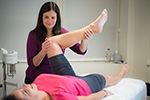Preserving Hip Health in Adolescents: Early Signs Parents Should Never Ignore
The foundation for lifelong mobility is built during the high-impact years of adolescence. As teenagers navigate growth spurts and competitive sports, lingering "growing pains" can sometimes mask serious orthopedic conditions that require expert attention. Learning to spot these hidden cues allows you to safeguard your child’s active lifestyle for years to come.





